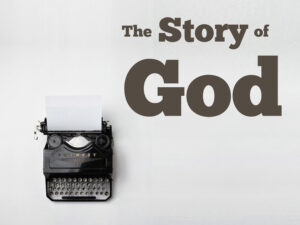 We’re making a significant shift at the GCR Church in our hermeneutic, the lens through which we read and interpret the Scriptures. We’re intentionally moving away from viewing the Bible primarily as a collection of commands and laws and toward seeing the Bible as the grand, sweeping, epic narrative of who God is and what he is doing in the world. We’re introducing it to the church over these seven weeks in what we’re calling The Story of God.
We’re making a significant shift at the GCR Church in our hermeneutic, the lens through which we read and interpret the Scriptures. We’re intentionally moving away from viewing the Bible primarily as a collection of commands and laws and toward seeing the Bible as the grand, sweeping, epic narrative of who God is and what he is doing in the world. We’re introducing it to the church over these seven weeks in what we’re calling The Story of God.
The Bible is a story. God reveals himself to us in history, through incarnation, Gospel, mighty acts, relationship, and promise. He could have given us a systematic theology or a constitution if he wanted to. He very easily could have prepared the checklists and the bullet points of what he wants out of his people. But he didn’t reveal the truth of himself or his mission that way. Instead, he chose to give us a story. He gives us poetry and prose, songs and parables – all of it in a narrative form. It’s a story.
The Story of God has a beginning and an end. It has a catastrophe that threatens the story and a plan and a mission to set everything right. It has a main stage and a main character. And from start to finish, it’s beautiful and inspirational. Eternal.
Act One – Creation: The Pattern of the Kingdom (Genesis 1-2)
Act Two – Crash: The Perished Kingdom (Genesis 3-11)
Act Three – Covenant: The Promised Kingdom (Genesis 12-Malachi 4)
Act Four – Christ: The Present Kingdom (Matthew 1-John 21)
Act Five – Church: The Proclaimed Kingdom (Acts 1-Revelation 20)
Act Six – New Creation: The Perfected Kingdom (Revelation 21-22)
We believe reading and understanding the Scriptures as one holy narrative will help us better connect the dots in the Bible, better identify with the story and find our own place in the mission of God, and more accurately interpret God’s purposes and will.
Let’s take that first one today. Connecting the dots.
We connect with one another through our stories. In a room of strangers, we tell stories about our hometown or our first job, trying to find some common ground around which to begin a relationship. You’re from Clovis? I have an aunt who lives in Clovis! Do you know Pam Lewis? That’s how we do it. And that’s how our Lord does it.
Jesus connects all the dots in the story. That’s what he told the religious leaders in John 5: “The Scriptures all point to me; the story is about me.”
In Exodus 24, Moses and the priests, representing all of God’s people, are eating and drinking with God on Mt. Sinai because they have been washed in blood. Moses says “the blood of the covenant.” At the last supper with his disciples, Jesus quotes Moses from Exodus 24 and says, “This is my blood of the covenant.”
The Hebrews sacrifice a Passover lamb on the night of God’s great deliverance. The Gospels say Jesus is the Lamb of God and he was sacrificed on Passover.
The Gospel of John takes the beautiful language of Creation from Genesis 1 and the spectacular imagery of New Creation from Revelation 21 and ties it all together in Jesus. He was with God “in the beginning.” He is the light shining in the darkness.
The story tells us that when you pass through the waters, everything changes. When you walk through the waters of the Red Sea, God is moving you from slavery to freedom. When you cross the waters of the Jordan River, God is moving you from wandering in the wilderness to settling in the land of promise. When you go through the waters of baptism, you pass from death to eternal life.
The Story of God connects all the dots in the Bible and gives us a common language and common touch points and experiences to connect us to the Lord and to one another.
All of life is a story. Everybody is living their story and finding their identity and basing their actions on the story they’re in. Everyone’s looking for the big story, the one Great Story that’s above the others and helps us make sense of all the others. The Story of God is that story. It’s large enough to be bigger than you, it calls you to something and someone beyond yourself. But it’s also intimate enough to involve you personally. God so loved the whole world that he gave his one and only Son. And that Son who came for the whole world also came for you. He knows you by name. Outside the garden tomb: Mary. Inside your fishing boat: Peter, Son of Jonah.
Peace,
Allan
Leonard,
I hope your discussion include the midrash approach used by our Jewish brothers and sisters. Which also includes looking at the time, place and context of when it was originally written and who it was written for.
48
The narrative hermeneutic (method of reading and interpretation) finds its life in the Jewish origins of the holy Scriptures. The Jewish people know how to live into and through the Story. I’ll have a little more to say in the next post about more easily finding our individual and collective identities by viewing the Bible as Story.